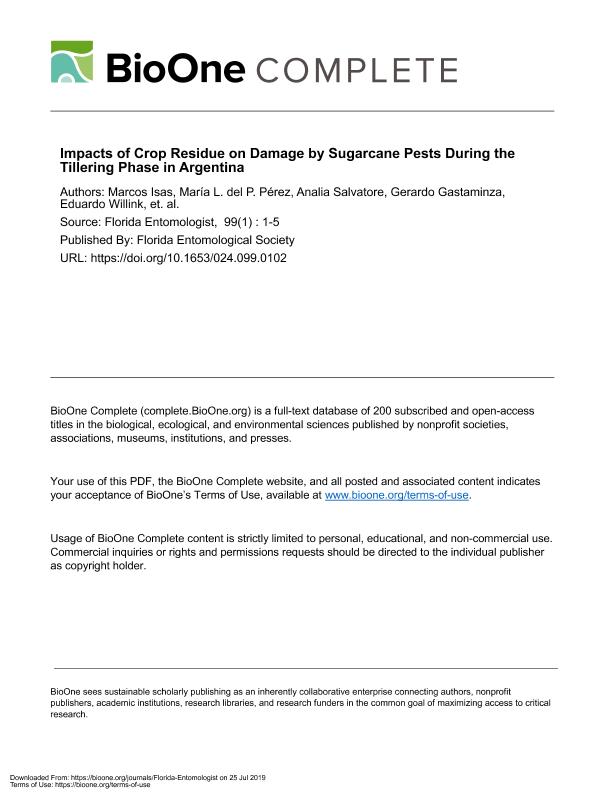Artículo
Impacts of Crop Residue on Damage by Sugarcane Pests during the Tillering Phase in Argentina
Isas, Marcos Gerardo ; Perez, Maria Lucia del Pilar
; Perez, Maria Lucia del Pilar ; Salvatore, Analia; Gastaminza, Gerardo; Willink, Eduardo; White, William
; Salvatore, Analia; Gastaminza, Gerardo; Willink, Eduardo; White, William
 ; Perez, Maria Lucia del Pilar
; Perez, Maria Lucia del Pilar ; Salvatore, Analia; Gastaminza, Gerardo; Willink, Eduardo; White, William
; Salvatore, Analia; Gastaminza, Gerardo; Willink, Eduardo; White, William
Fecha de publicación:
03/2016
Editorial:
Florida Entomological Society
Revista:
Florida Entomologist
ISSN:
0015-4040
Idioma:
Inglés
Tipo de recurso:
Artículo publicado
Clasificación temática:
Resumen
One of the most important recent changes in sugarcane cultural practices in Tucumán, Argentina, is the adoption of the practice of green-cane harvesting, which involves harvesting the sugarcane crop in the absence of burning. The objective of this study was to assess the impact of the post-harvest crop residue (also sometimes known as "trash blanket") on Elasmopalpus lignosellus (Zeller) (Lepidoptera: Pyralidae) and Pseudaletia unipuncta Haworth (Lepidoptera: Noctuidae) population dynamics in sugarcane. The study was conducted in ratoon crops for 3 growing seasons (2011, 2012, and 2013) and at 3 locations in the state of Tucumán, Argentina. The treatments consisted of rows with the crop residue burned and the crop residue retained. Removal of the crop residue by burning, compared with retention, resulted in significantly greater crop damage by E. lignosellus in all locations and years. In contrast, damage by P. unipuncta was observed exclusively on plots where crop residue was retained. Comparing the pest status of 2 insects, E. lignosellus seems to be more consistently deleterious to sugarcane yield than P. unipuncta, and chemical control of this species is not very effective. Therefore, leaving the crop residue in place seems to be the most appropriate crop management approach, although it is important also to monitor P. unipuncta populations in order to implement control should it be necessary.
Palabras clave:
Green Harvest
,
Lesser Cornstalk Borer
,
Stubble
,
Trash Blanket
,
True Armyworm
Archivos asociados
Licencia
Identificadores
Colecciones
Articulos(ITA-NOA)
Articulos de INST. DE TECNOLOG. AGROINDUST. DEL NOROESTE ARGENTINO
Articulos de INST. DE TECNOLOG. AGROINDUST. DEL NOROESTE ARGENTINO
Citación
Isas, Marcos Gerardo; Perez, Maria Lucia del Pilar; Salvatore, Analia; Gastaminza, Gerardo; Willink, Eduardo; et al.; Impacts of Crop Residue on Damage by Sugarcane Pests during the Tillering Phase in Argentina; Florida Entomological Society; Florida Entomologist; 99; 1; 3-2016; 1-5
Compartir
Altmétricas



